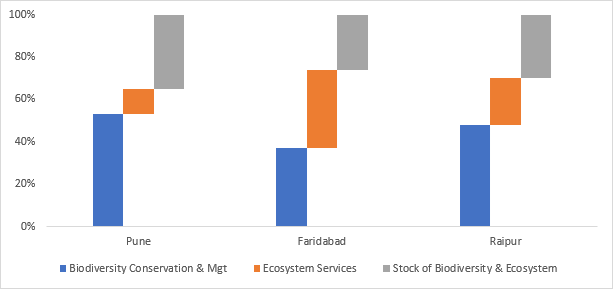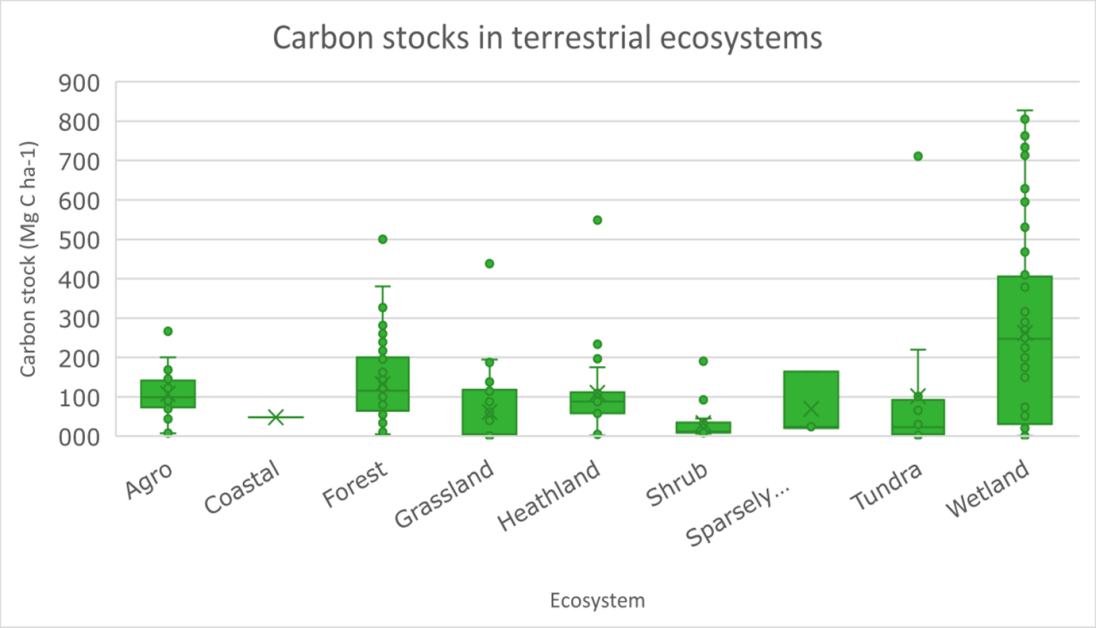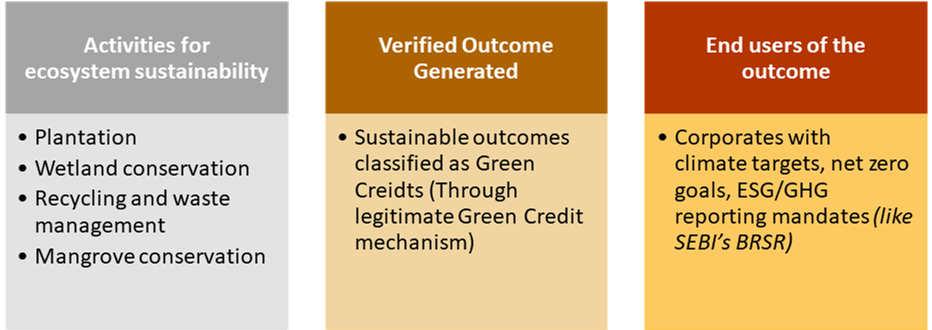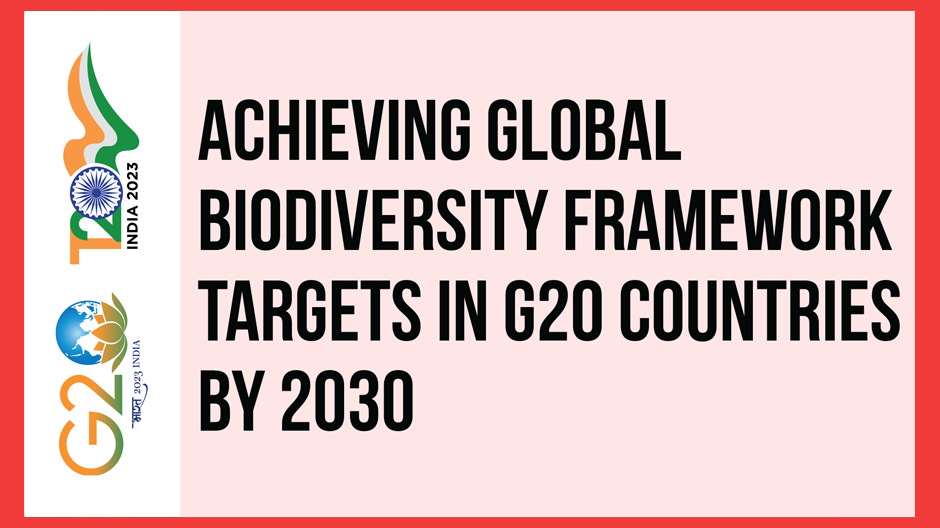Task Force 6: Accelerating SDGs—Exploring New Pathways to the 2030 Agenda
For the G20 countries with fast-depleting biodiverse species (such as Brazil, China, India, Indonesia, Mexico, and Türkiye), achieving the 30×30 goal (protecting 30 percent of the world’s land and oceans by 2030) is challenging. This policy brief explores the ways in which the G20 countries can achieve the Global Biodiversity Framework (GBF) targets by 2030. First, by promoting urban biodiversity and ecosystem conservation through a localised index, such as developing and implementing a City Biodiversity Index at the city municipal level. Second, through effective management policies to enhance carbon sequestration by different ecosystems while achieving the GBF targets. To achieve net-zero targets, strengthening the carbon sequestration potential of ecosystems is important. Policies should be implemented to efficiently manage wetlands and blue carbon ecosystems with the highest carbon sequestration and storage potential. The third way to achieve the GBF targets is through innovative financing for biodiversity conservation. The monetary valuation of ecosystem services is essential for mobilising resources from the private sector. The “green credit” mechanism could be one innovative financial mechanism for biodiversity-rich G20 countries to consider for the successful and effective implementation of conservation policies.
1. The Challenge
Current research show that the possibility of climate change overtaking land use and land cover (LULC) changes by 2070 would be the primary cause of biodiversity loss (Newbold 2018; Dasgupta, 2021). Biodiversity loss will hugely worsen the climate change condition as massive amounts of carbon, which was stored in the form of animal lives and captured by vegetation, will be emitted into the atmosphere (Dasgupta, 2021). At COP15, countries decided to take up the Post-2020 Global Biodiversity Framework (GBF) to stop and reverse the loss of biodiversity by 2030. The GBF is the first global framework since the Aichi Biodiversity Targets (2010). The draft GBF comprises 22 targets and four goals, and aims to protect 30 percent of the world’s land and oceans by 2030—termed the 30×30 goal. There are four major challenges to achieving the GBF targets:
- Given the anthropogenic pressure and climate change issues, it is challenging to curb the speedy extinction of different flora and fauna species. Most countries have their own national biodiversity policies, and large countries like India also implement state biodiversity strategies and action plans for different states. However, given the rate of biodiversity loss extinction, more is needed. Public awareness and active participation in biodiversity conservation are the need of the hour. Thus, it is essential to develop city-wise or municipality-wise local action plans based on biodiversity stock taking or inventory are essential, which is lacking in most cities lack.
- Achieving net zero emission within a specified time period is a major challenge. Most countries now aim to reach their net-zero targets. Besides emission reduction, carbon sequestration by different ecosystems can help in achieving net zero targets. As per the Paris Agreement, nationally determined contributions require notifying the measure of carbon stored in a country to estimate its voluntary reduction of carbon emissions. The carbon sequestration characteristics of wetlands and blue carbon ecosystems create massive potential in offsetting carbon emissions (Taillardat et al., 2018; Alongi, 2020). But management and conservation of these ecosystems are far from sufficient. Due to a lack of conservation and monitoring, mangroves are reducing worldwide, reducing coastal resilience, and increasing disaster vulnerability. Though wetlands are substantial carbon sinks, without wise usage of wetlands and lack of integrated management, they may soon become carbon emitters. So, this is challenging and needs attention to effectively manage and conserve mangroves and wetlands.
- Climate-induced negative impacts on biodiversity and ecosystem need to be tackled. The Global Assessment for Biodiversity and Ecosystem Services report by the Intergovernmental Science-Policy Platform on Biodiversity and Ecosystem Services (IPBES) identifies six major threats for biodiversity (here, blue carbon ecosystem) losses: changes in LULC; changes in sea level; sea acidification; climate change; pollution; and the direct exploitation of organism, invasive alien species, and so on.
Two more major threats are peoples’ lack of attachment to nature and inadequate recognition of the value of nature (Bongaarts, 2019).
- Mangroves and other blue carbon ecosystems are facing significant challenges in their survival. Anthropogenic threats, including deforestation, habitat fragmentation, high rates of land degradation, urbanisation, expansion of agriculture, aquaculture farms near mangrove patches, and the construction of ports, jetties, and water transportation in close proximity to these areas, are causing damage to mangrove habitats, inhibiting their natural regeneration and growth (Kadaverugu et al. 2022). Soil erosion and nutrient loss are also impacting blue carbon ecosystems.
2. The Role of the G20
Most G20 countries are biodiversity hotspots and home for many unique, threatened, and endangered flora and fauna. As such, sufficient funds will need to be allocated for biodiversity conservation. The monetary valuation of biodiversity and ecosystems is crucial for mobilising resources for restoration, protection, and conservation. Biodiversity financing is about raising and managing capital and using financial incentives to support sustainable biodiversity management and is a current topic of discussion and planning. It links their practices, strategies and policies with biodiversity financing initiatives (Bhattacharya and Bhattacharya, 2019). This concept of linking the economy with biodiversity is expectedly helpful in properly valuing biodiversity and its subsequent preservation and conservation. Financial needs for global biodiversity conservation are estimated at USD150–440 billion annually (Arlaud et al., 2018). Extracting the investment from the private sector for biodiversity and ecosystem services conservation is yet a big challenge for biodiversity financing.
The role of G20 countries under the presidency of India is to adopt the “three-step approach” to implement GBF among member countries by 2030, as a comprehensive approach towards ecosystem and biodiversity conservation and climate mitigation. G20 countries shall utilise India’s G20 presidency to begin identifying the common but differentiated measuring indicators of biodiversity at the urban level in each of the member countries. Developing the standard framework for city-level biodiversity indexing could be an important contribution of the member countries. They shall also utilise India’s G20 presidency to work on effective management policies for enhancing carbon sequestration across various different ecosystems, while concurrently achieving the GBF targets in line with India’s recently declared initiatives, namely the Amrit Dharohar Yojona for wetland conservation and MISHTI (Mangrove Initiative for Shoreline Habitat & Tangible Incomes). In order to promote financing for biodiversity and ecosystem conservation, G20 countries shall work together to develop the framework for the valuation of ecosystems and biodiversity to mobilise resources. G20 countries shall work towards developing the framework for green credit, which could be further adopted as common trading certificates for conservation activities to generate resources within the group.
Measuring developmental progress majorly depends on internationally comparable, reliable, granular, and timely data. This data should be amenable to disaggregation and based upon robust indicators, leading to multidimensional well-being metrics that encompass economic and social well-being as well as environmental and ecological sustainability. Moreover, adopting a new measurement framework for intergenerational and comprehensive well-being, which is acceptable, will necessitate significant international cooperation. Therefore, the G20, being influential in framing global policies within and outside of the group, is an ideal platform to impart traction to this work.
3. Recommendations to the G20
This section highlights steps that can be taken to adopt and implement the GBF targets across the member countries of the G20.
Proposal 1: Urban biodiversity and ecosystem conservation through local indexing mechanism
Along with initiatives like the people’s biodiversity register, City Biodiversity Indexing (CBI) should be mandatory for all cities in G20 countries. CBI or the Singapore Index is an inventory or stock-taking tool for cities and municipalities to assess and monitor the status of their biodiversity conservation efforts against their baseline.
The CBI comprises of two parts: (a) the ‘profile of the city’, which provides the city’s background information, including biodiversity and ecosystem status, geographical and demographical profile, and more; (b) and the 28 indicators used to assess native biodiversity, ecosystem services, management of biodiversity by local governments, children’s awareness programmes, and educational curriculum based on guidelines and methodology provided in the ‘User’s Manual on The Singapore Index on Cities’ Biodiversity’ (Convention on Biological Diversity, 2021).
Biodiversity and ecosystem services are among the other factors maintaining the sustainability of a city. The CBI is significant for local governments and municipalities, serving both as a motivational tool and a means to provide incentives for inventorying and monitoring biodiversity programmes. By doing so, it enables these entities to enhance the long-term sustainability of their cities (Bhattacharya, 2017).
The CBI has been implemented in a few Indian cities and should be implemented in others too. We have conducted CBI for three smart cities in India—Pune, Faridabad and Raipur—and found severe lack of data. Despite its limitations, the CBI scores could identify gaps in biodiversity conservation and related programs within these cities (see Figure 1), and point out areas that require attention to enhance biodiversity and ecosystem status (Bhattacharya, 2017).
Figure 1: Comparison of CBI indicators among the cities

Source: Bhattacharya, 2017
Proposal 2: Effective management policies for enhancing carbon sequestration and protection of biodiversity in different ecosystems
Wetland Ecosystem
To ensure ecological security, there is an urgent need to protect and conserve wetlands and other ecosystems. Wetlands have maximum carbon sequestration potential among different ecosystems (see Figure 2). But if wetland management is not done regularly or in a prescribed manner, they could become carbon emitters (Biswas et al., 2017). Therefore, wise use of wetlands and integrated management and regular monitoring are crucial for wetlands, which can increase the carbon sequestration rate multifold.
Figure 2: Wetland has the maximum CO2 sequestration potential among other ecosystems

Source: Hendriks et al.,2020
Globally, carbon dioxide (CO2) emissions from damaged peatlands are well over 3,000 million tons annually, or over 11 per cent of global fossil fuel emissions (Hendriks et al. 2020). Minimal efforts towards halt these emissions is being noticed. As G20 countries possess numerous wetlands and water bodies crucial for achieving the net zero target and enhancing carbon sequestration, governments should prioritise wetland management as an urgent and significant policy.
Major action points
- A State Wetland Assessment will be conducted with the assistance of a Wetland Health Card, utilizing GPS techniques.
- Regular reporting of emissions halting, capturing and net emissions, along with accounting for them in the state emissions inventory is needed.
- Regular awareness programmes for stakeholders should be held.
- Maintain ecological parameters, including the combination of ecosystem components, processes, and the benefits/services provided by wetland.
Blue carbon ecosystems
The coastal blue carbon ecosystems play a vital role in atmospheric CO2 sequestration that could significantly contribute in achieving net zero targets and climate change mitigation (Taillardat et al., 2018). Blue carbon refers to the carbon captured by vegetated coastal habitats and stored by living marine organisms (Nellemann et al., 2009). Mangroves, salt marshes and seagrass meadows are termed blue carbon because of their high carbon stocks and long-term carbon storage capacity (Akhand et al., 2022). They store carbon in their above-ground biomass, meaning leaves, stems and branches, and roots, as well as non-living biomass like litter and deadwood and underlying sediments (Bertram et al., 2021; Kuwae & Hori, 2019; Macreadie et al., 2019; Chen and Xu, 2020; Akhand et al., 2022).
Mangrove ecosystems play a crucial role in balancing coastal ecosystems by providing provisioning, regulating, supporting, cultural and aesthetic ecosystem services. Additionally, they also contribute to climate disaster resilience in coastal areas.
India has a long coastline of more than 7,500 km enriched with all three blue carbon ecosystems (Kathiresan, 2018; Jayanthi et al., 2018; Thangaradjou and Bhatt, 2018). Carbon stored in the Indian mangroves is US$469–5427 million. Table 1 shows the commercial value of blue carbon ecosystems in India (Pendleton et al., 2012; Akhand et al., 2022). According to statistics, India’s blue carbon store value is approximately equivalent to the minimum amount of carbon lost worldwide annually.
Table 1: Value of blue carbon ecosystem in India and its mean value
| Blue carbon ecosystem of India | Worth of capture carbon (in million US$) | Mean value (in million US$) |
| Mangroves | 469–5,427 | 2,747 |
| Salt marshes | 0.034–0.397 | 0.201 |
| Sea grasses | 0.441–5.103 | 2.583 |
Source: Akhand et al., 2022
Therefore, the protection and enhancement of blue carbon ecosystems should be priority policies for G20 governments.
Major action points
- There is an urgent need to quantify the ecosystem services provided by mangroves to accelerate mangrove conservation and secure blended financing for the preservation of these ecosystems.
- Different ecosystem service valuation methods, such as IPBES methods, natural capital accounting, invest modelling, cost-benefit analysis, and travel cost methods, must be employed to calculate the exact commercial values of blue carbon.
- The integrated valuation of ecosystem services and trade-offs (InVEST) model ca be utilised to quantify carbon sequestration, sediment retention and export, and nutrient export (Kadaverugu et al., 2022; Dasgupta, 2021; Hashimoto et al., 2019)
- Increased utilisation of remote sensing and GIS-basd surveying for ecosystem monitoring, integrated management and resource conservation is crucial for the protection of mangroves (Hashimoto et al., 2019) should be utilized for mangrove protection.
- Coastal conservation and developmental measures, along with efforts to arrest soil erosion, are required to reduce the effects of storm surges, cyclones and other coastal disasters.
- Scenario analysis to be utilised to improve decision-making processes and create effective conservation policies for blue carbon ecosystems (Hashimoto et al., 2019).
Proposal 3: Innovative financing for biodiversity conservation through a green credit system
Green credit mechanism
Exploring the option of a green credit mechanism, which is currently being promoted by the Government of India could be an innovative financial mechanism for implementing biodiversity action plans for all G20 countries. The following steps could be taken up in estimating investment requirements for India’s biodiversity and ecosystem conservation and enabling access to available finance to create new financial possibilities (Figure 3).
Figure 3: Basic steps for estimating green finance requirement

Source: Authors’ own
The basic concept of the green credit mechanism for biodiversity and ecosystem conservation involves environmental traders, who would export green or carbon credits from areas enriched with a higher environmental biodiversity value to those with a lower value (e.g., less forest or biodiversity) (Higashida et al. 2019). Institutional frameworks are required for market mechanisms to work effectively under conservation banking schemes (Figure 4).
Figure 4: A market-based mechanism to promote ecosystem sustainability


Source: Authors’ own
Green credit permits can be traded between two regions, even if their trading schemes are different. When a participant in the scheme restores a unit area of an indigenous ecosystem, and the scheme certifies the restoration, the participant receives a unit of credit. The restorer or banker can then sell the credits received to other participants in the credit market. When another participant develops a certain number of the ecosystem’s units for an economic project, such as a resort development or factory construction, those ecosystem units are lost. If it is difficult for developers to restore the ecosystems, they must buy credits from the market or bankers. When the targeted ecosystems are wetlands, streams and other aquatic resources, this type of scheme is called mitigation banking. Historically mitigation banking schemes started in the 1980s. Today, conservation banking schemes are being increasingly implemented in countries like the US, Australia, France, and Germany. It is time for all G20 countries to take up green credit mechanisms for conservation financing (Higashida et al., 2019). The Indian government rightly promotes the green credit mechanism, especially in the high-priority sectors like forest ecosystem services, water, waste management and transport; it and should be increasingly implemented for biodiversity and ecosystem conservation for all G20 countries, especially the tropical ones like Brazil, Mexico and Indonesia.
Major action points
- Attracting adequate financial resources for conservation purposes can be achieved through innovative mechanism, such as linking to the national plan of the green credit mechanism and utilising CSR funds.
- Blended finance planning is needed to ensure a combination of public and private funding accumulation for conservation efforts.
Proper analysis of the government’s budget and state appropriation account should be done as primary step for finance planning.
Attribution: Tania Ray Bhattacharya, Shunsuke Managi, and Rajarshi Dasgupta, “Achieving Global Biodiversity Framework Targets in G20 Countries by 2030,” T20 Policy Brief, July 2023.
Bibliography
Akhand, Anirban, Abhra Chanda, Yusuf Jameel, and Rajarshi Dasgupta. “The present state-of-the-art of blue carbon repository in India: a meta-analysis.” Sustainability Science (2022): 1–12.
Arlaud, Marco et al. “The biodiversity finance initiative: an approach to identify and implement biodiversity-centered finance solutions for sustainable development.” Towards a Sustainable Bioeconomy: Principles, Challenges, and Perspectives (2018): 77–98.
Alongi, Daniel M. “Global significance of mangrove blue carbon in climate change mitigation.” Sci 2, no. 3 (2020): 67.
Bertram, Christine, Martin Quaas, Thorsten BH Reusch, Athanasios T. Vafeidis, Claudia Wolff and Wilfried Rickels. “The blue carbon wealth of nations.” Nature Climate Change 11, no. 8 (2021): 704–709.
Bhattacharya, Tania and Anindya Bhattacharya. “Financing biodiversity action plan using state appropriation account analysis: A case study of an Indian state.” Ecosystem Services 39 (2019): 100971.
Bhattacharya, T.R. “Comparative assessment of ecosystem and biodiversity conservation measures in Indian smart cities: a city biodiversity index approach.” Int J Sustain Futur Hum Secur 5, no. 2 (2017): 18.
Biswas, Protusha, Tania Bhattacharya, Abhra Chanda, Sourav Das and Sugata Hazra. “Urban wetlands–CO2 sink or source? A case study on the aquaculture ponds of East Kolkata wetlands.” Int J Recent Sci Res 9 (2018): 24158–24165.
Bongaarts, John. “IPBES, 2019. Summary for policymakers of the global assessment report on biodiversity and ecosystem services of the Intergovernmental Science‐Policy Platform on Biodiversity and Ecosystem Services.” Population and Development Review (2019): 680–681.
Chen, Yimin and Changan Xu. “Exploring new blue carbon plants for sustainable ecosystems.” Trends in plant science 25, no. 11 (2020): 1067–1070.
Convention on Biological Diversity. “User’s manual on The Singapore Index on cities’ biodiversity.” Accessed 25 March 2023.
Dasgupta, Partha. “The Economics of Biodiversity: The Dasgupta Review. Abridged Version.” 2021.
Dabkara, Manish. “Green-credit program: affirming the vision for a net zero future.” EKI Energy Services Limited. February 15, 2023. Accessed March 25, 2023.
Hashimoto, Shizuka et al. “Scenario analysis of land-use and ecosystem services of social-ecological landscapes: implications of alternative development pathways under declining population in the Noto Peninsula, Japan.” Sustainability Science 14 (2019): 53–75.
Hendriks, Kees, Susan Gubbay, Eric Arets and John Janssen. “Carbon stocks and sequestration in terrestrial and marine ecosystems: a lever for nature restoration?”
Higashida, Keisaku, Kenta Tanaka and Shunsuke Managi. “The efficiency of conservation banking schemes with inter-regionally tradable credits and the role of mediators.” Economic Analysis and Policy 62 (2019): 175–186.
Jayanthi, M., S. Thirumurthy, G. Nagaraj, M. Muralidhar, and P. Ravichandran. “Spatial and temporal changes in mangrove cover across the protected and unprotected forests of India.” Estuarine, Coastal and Shelf Science 213 (2018): 81–91.
Kadaverugu, Rakesh et al. “Scenario-based quantification of land-use changes and its impacts on ecosystem services: a case of Bhitarkanika mangrove area, Odisha, India.” Journal of Coastal Conservation 26, no. 4 (2022): 30.
Kathiresan, K. “Mangrove forests of India.” Current Science (2018): 976–981.
Kuwae, Tomohiro and Masakazu Hori. Blue carbon in shallow coastal ecosystems. Blue Carbon Shallow Coast. Ecosyst 1, no. 10 (2019).
Macreadie, Peter I. et al. “The future of Blue Carbon science.” Nature communications 10, no. 1 (2019): 3998.
Nellemann, Christian and Emily Corcoran, eds. “Blue carbon: the role of healthy oceans in binding carbon: a rapid response assessment.” UNEP/Earthprint, 2009.
Newbold, Tim. “Future effects of climate and land-use change on terrestrial vertebrate community diversity under different scenarios.” Proceedings of the Royal Society B 285, no. 1881 (2018): 20180792.
Pendleton, Linwood et al. “Estimating global ‘blue carbon’ emissions from conversion and degradation of vegetated coastal ecosystems.” PLoS ONE 7(9): e43542.
Taillardat, Pierre, Daniel A. Friess and Massimo Lupascu. “Mangrove blue carbon strategies for climate change mitigation are most effective nationally.” Biology Letters 14, no. 10 (2018): 20180251.
Thangaradjou, T. and J.R. Bhatt. “Status of seagrass ecosystems in India.” Ocean & Coastal Management 159 (2018): 7–15.
United Nations. “Report of the Conference of the Parties on its fifteenth session, held in Abidjan, Côte d’Ivoire, from 9 to May 20, 2022.” June 17, 2022. Accessed March 25, 2023.





